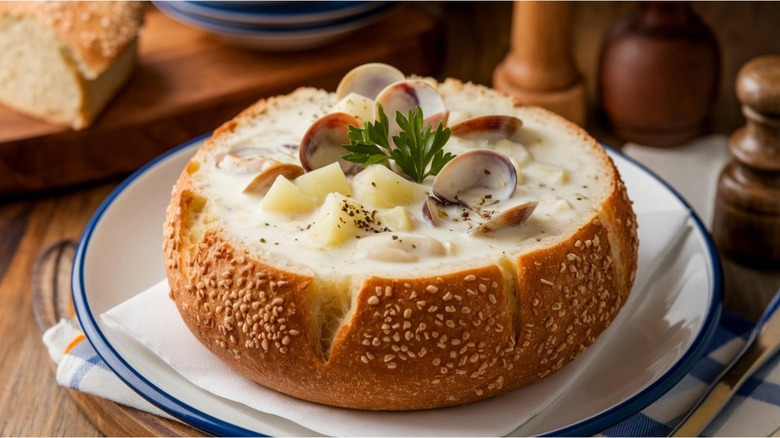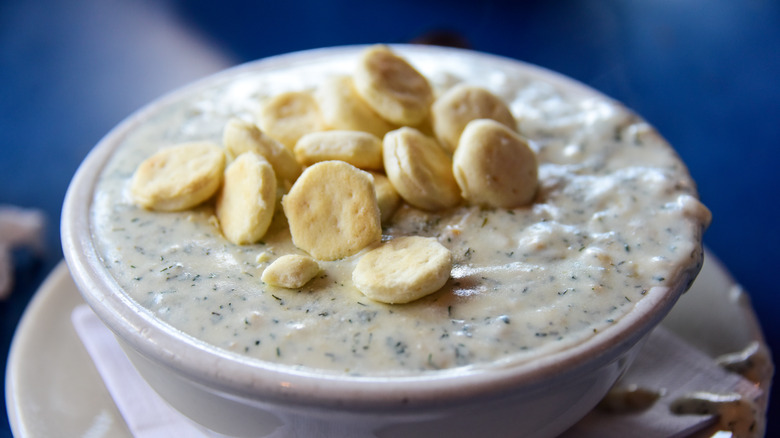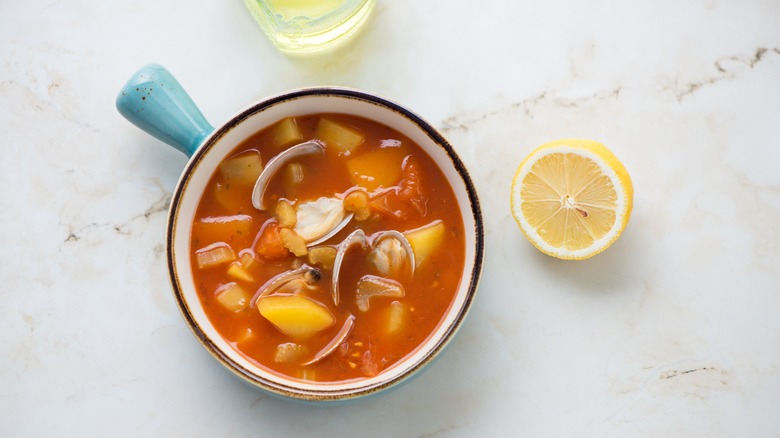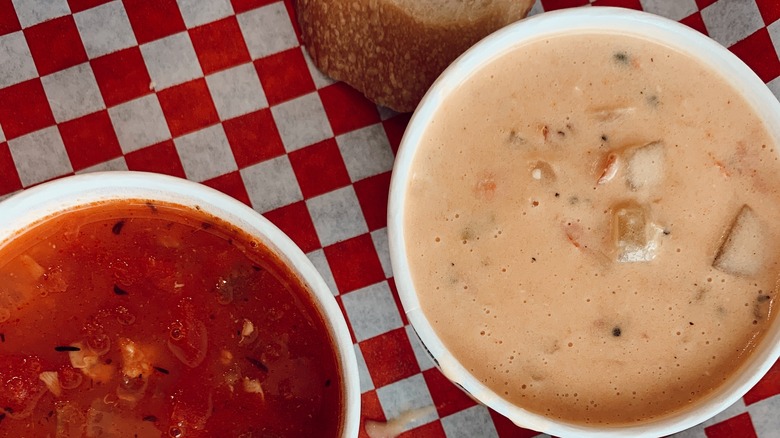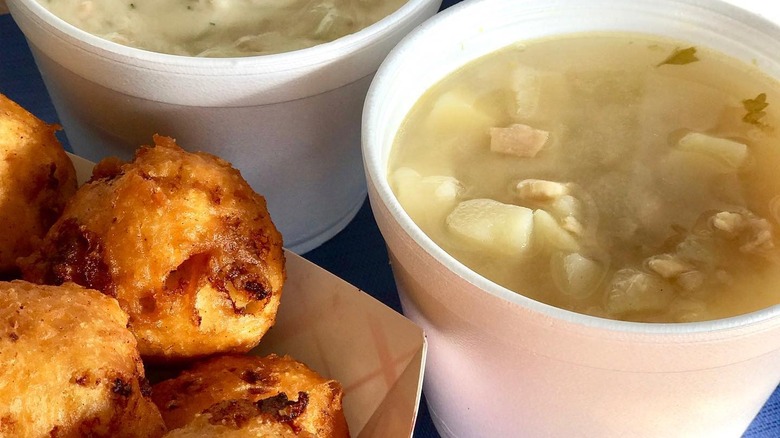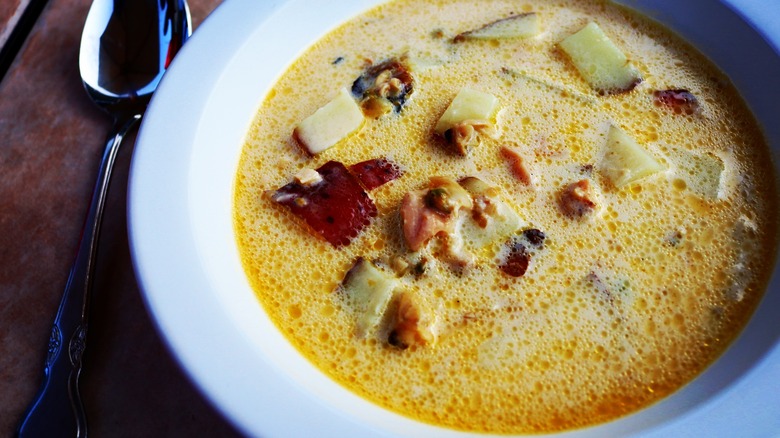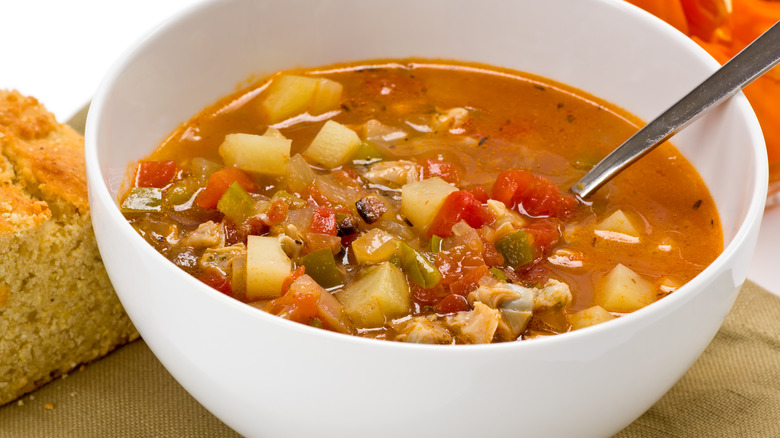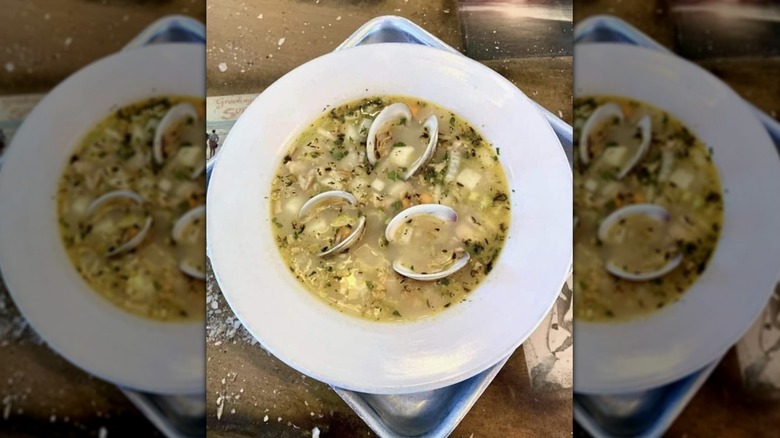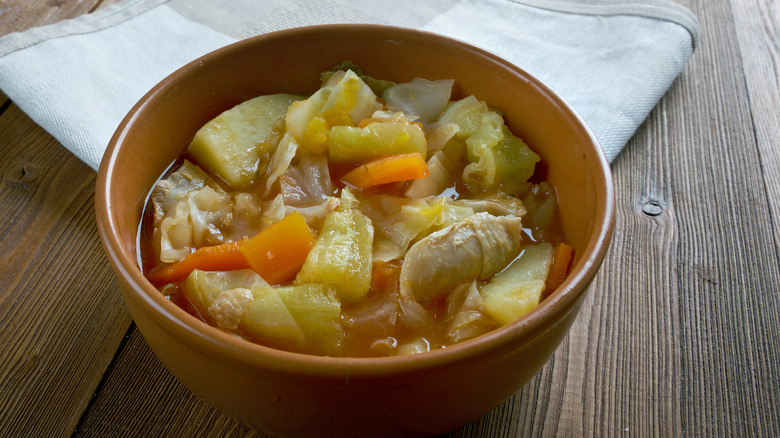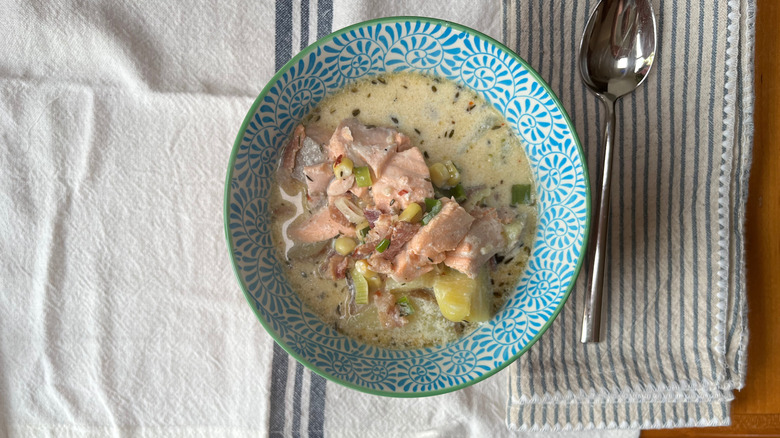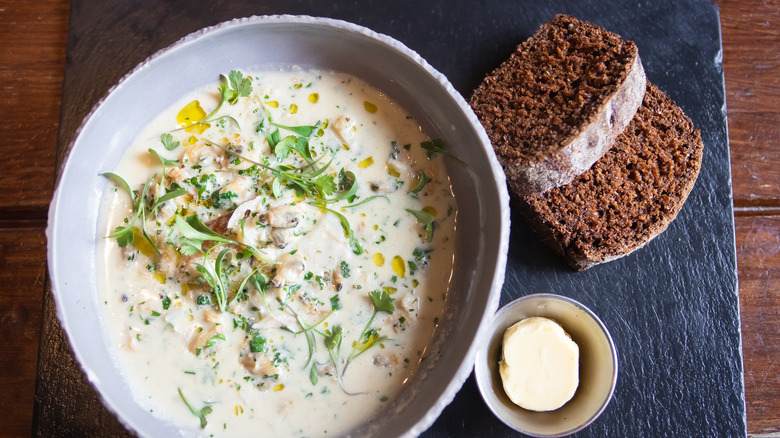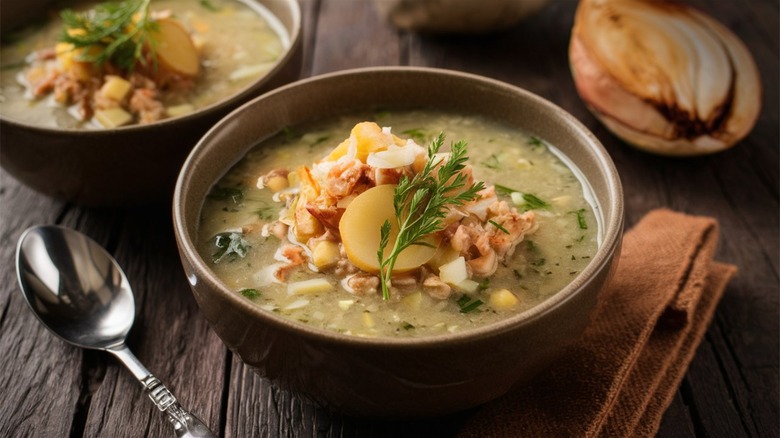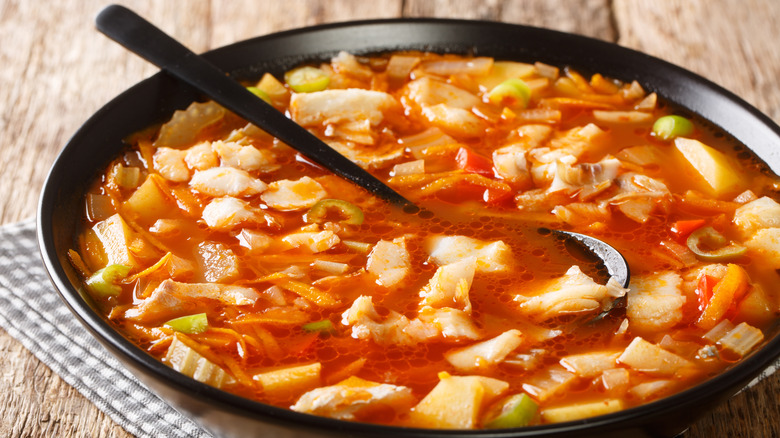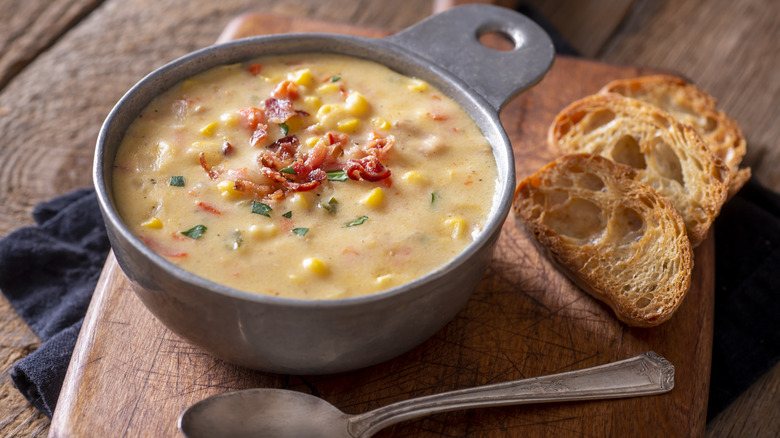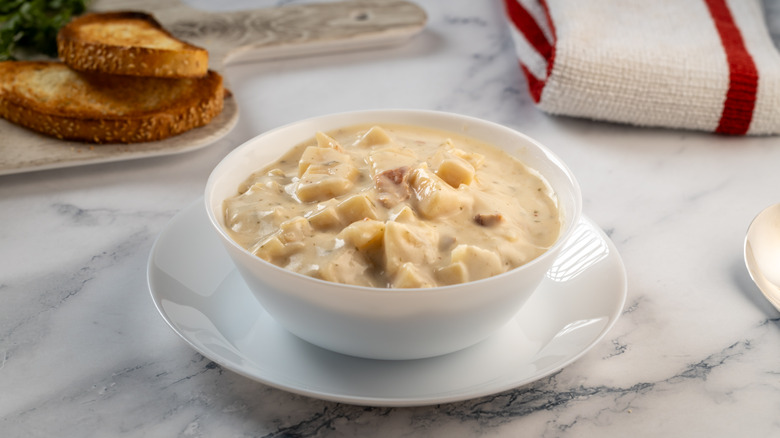14 Types Of Chowders And What Makes Them Unique
When you think of "chowder," what do you imagine? Probably a creamy soup filled with chunks of potato and some sort of seafood, likely clams. It's assumed chowder first appeared in the small fishing villages of Brittany, and then the made its way across the European continent and eventually across the waters, to England and then eventually to North America. There, the hearty, easy, and accessible seafood-rich soup found a home in similar fishing villages. While it's not entirely clear who exactly spread the good word of chowder across the world (whether traveling sailors, immigrants, or a mix of both), by the 1800s, chowder had appeared in American cookbooks.
As chowder spread, though, it also changed. Ingredients were swapped out, making use of what was geographically on hand. As a result, today, your version of chowder may be different from another person's version, particularly if they live across the country or the world. For example, corn chowder is wildly different from New England clam chowder; even if you keep the clams, chowder can differ heavily from location to location, as is seen when you compare New England and Manhattan clam chowders. Here are some of the most popular types of chowders and what makes them unique.
New England clam chowder
Possibly the most well-known type of chowder — you can buy it in just about any grocery store that sells canned soup — New England clam chowder (also sometimes called Boston clam chowder) features a creamy broth base, potatoes, and, of course, clams. Depending on your recipe, you might also add bacon, onions, and celery to the mix, but you always serve it with a side of oyster crackers. It's the creamy broth that really makes New England clam chowder stand out from a lot of others, though. Whereas Manhattan clam chowder often has a red-tinted broth, and corn chowder a yellow-tinted broth, a classic New England clam chowder is stark white.
Perhaps one of the primary reasons why New England clam chowder is so iconic and well-known is because it's simply old. Restaurants were serving Boston clam chowder in the city in the early 1800s, with some tracing the chowder's origins in the area back to the 1700s.
Manhattan clam chowder
Manhattan clam chowder does not contain the milk or cream that you would add to New England clam chowder, so it doesn't have a thick, white broth. Instead, the broth is a mixture of clam juice and chicken broth, and, thanks to the addition of tomatoes, it's a shade of red similar to what you might see in a vegetable soup. Manhattan clam chowder does still use the clams and potatoes that you would find in New England clam chowder, but the thinner broth is bulked up by the addition of more overall vegetables, such as bell peppers or carrots.
Some believe that immigrant populations from Portugal brought the chowder with them to Manhattan, where it then took root. Other reports, however, claim that a Manhattan fish market, which sold a clam chowder originally more similar to New England clam chowder, started making Manhattan-style clam chowder only after milk became too expensive. Whatever the origins, though, this chowder is polarizing. While some love it, others think it's not worthy of mentioning in the same breath as New England clam chowder.
Long Island clam chowder
Long Island and Manhattan aren't that far apart — maybe 50 miles. Can chowder from the two destinations really be so different? Well... kind of. Long Island clam chowder is somewhat similar to Manhattan clam chowder, as well as New England clam chowder. Think of it like if the Manhattan and New England chowders got together and had a little chowder baby. That's what you'll get in Long Island. In fact, some restaurants have taken this idea of Long Island clam chowder so literally that they just blend half a bowl of each of the two parent chowders together and call it a day.
The color is likely the first thing you'll notice. What do you get when you mix white and red? Pink — so, yes, this chowder is pink, thanks to Manhattan's tomatoes and New England's dairy. Otherwise, the chowder is fairly straightforward and unsurprising, with the requisite clams, potatoes, bacon, and a few vegetables.
Rhode Island clam chowder
Rhode Island clam chowder could be defined as "the clear one." That's right, rather than a white, red, or pink broth, Rhode Island clam chowder has a clear broth. The clear broth is not chicken broth, though. Instead, it's fully clam broth and clam juice. This broth is the main differentiator and, otherwise, the chowder is pretty standard, utilizing clams, potatoes, bacon, celery, and onion.
While Long Island clam chowder has only gained popularity relatively recently, Rhode Island clam chowder shares the Manhattan and New England chowders' longevity. A clear clam chowder recipe can be traced back to an 1888 cookbook (though that recipe does throw in some tomatoes, a la Manhattan). Other reports call Rhode Island clam chowder the true original American chowder, enjoyed by Indigenous populations, rather than introduced by immigrants. Indigenous populations wouldn't have had access to the dairy needed to make New England clam chowder. Cows were introduced to North America by the Europeans, with mass importations occurring until the 1640s.
Maine clam chowder
Yes, while Maine is technically part of New England, that doesn't mean that you'll find New England chowder there — at least not the same New England chowder that you'll find in Boston. Instead, Maine puts its own spin on the dish, for a chowder that's very similar to the Bostonian version, but with one key difference: It's not as thick.
Maine clam chowder does contain milk, so it has that white broth, but there's no thickening agent, like a roux, used in the cooking process. As such, you get a broth with a true broth consistency, versus the thicker texture (described by some as "gluey") found in classic New England chowder. In some recipes, though, crackers are crushed and mixed into the final product, which does thicken the chowder a bit. Maine clam chowder otherwise contains the same ingredients as its sibling to the south, including bacon, potatoes, onion, and clams.
Minorcan clam chowder
Clam chowder isn't just a northern dish, though. Travel far, far south to Florida, and you'll find a chowder unique to St. Augustine and the surrounding area: Minorcan clam chowder. The chowder is similar in appearance to Manhattan clam chowder, with a tomato-infused broth that omits any dairy, and it also contains more vegetables than a New England chowder, such as carrots and bell pepper (alongside the requisite potatoes and clams). The secret ingredient that really makes this chowder stand out from all the others, though, is the datil pepper.
Supposedly, indentured servants brought the datil pepper with them to Florida from Minorca, hence the chowder's name. Today, the descendants of those Minorcan immigrants are still using the peppers to make the region's unique chowder. It's no surprise if you don't recognize this chile's name, though. Datil peppers are similar to habaneros, but they're not quite as popular throughout most of the country. You may have a difficult time finding them outside of St. Augustine and the immediate surrounding areas.
Hatteras clam chowder
Also in the South, Hatteras clam chowder, sometimes called Outer Banks clam chowder, is native to the North Carolina coast (Hatteras is an island in the Outer Banks). Like Rhode Island clam chowder, Hatteras clam chowder is clear and puts the focus on the clams, with no dairy or tomatoes added. Some recipes will include bacon, red potatoes, and a mirepoix (a mix of diced onion, celery, and carrots), but others omit the carrots and celery, for a dish that's more or less just potatoes and clams in a seafood stock.
You can find Hatteras clam chowder sold at many restaurants around the region and families pass down their own recipes, but it's unclear how this chowder got its start. However, it is historically clear why this clam chowder leaves the dairy out of the equation. Until it became a tourism destination, the Outer Banks was a relatively poor region and most living there did not have the funds necessary to buy milk or own a dairy cow.
Southern Illinois chowder
The history of chowder would have you believe that this is a coastal state-only dish. Introduced by seafaring peoples and immigrants flocking from Old World fishing villages, chowder and fresh seafood traditionally go hand in hand. However, you can find unique chowders hundreds of miles from any ocean, as is the case in Illinois.
Southern Illinois chowder doesn't look like any other chowder on this list. It doesn't use any seafood. Instead, it combines beef and chicken. It also adds in a plethora of vegetables, including tomatoes, corn, multiple types of beans, potatoes, and celery. Seasoning is sometimes limited to salt, pepper, and hot sauce, for a chowder that's all its own.
Additionally, in Illinois, the word "chowder" doesn't just refer to the food. It also refers to an event where chowder is made. State tradition dictates that a chowder is a social occasion, wherein community members gather to cook chowder in large quantities, over an outdoor fire, in a cauldron, with continuous stirring. In the past, community members would donate individual ingredients for the chowder-making, whatever they produced on their farm and had handy.
Salmon chowder
If we continue making our way across the United States, sampling the various regional chowders as we go, eventually we'll hit salmon chowder country, aka the Pacific Northwest. While it is possible to find local chowders in the Pacific Northwest that incorporate clams, there are several reasons why salmon is sometimes preferred instead. West Coast clams aren't as flavorful. Sometimes they're stringy. They can also be expensive. Thus, salmon becomes a good choice.
From there, though, there are some deviations within the region. For example, some Northwest salmon chowder recipes share a quality in common with Long Island chowder: a pink hue. This isn't just because of the pink salmon. Some recipes may blend both dairy and tomatoes into the mixture, resulting in a pink broth. Still, other recipes may ditch the tomatoes and instead add corn into their salmon chowder for a result that's half-salmon chowder, half-corn chowder. Whatever the case, you're guaranteed a chowder that's filled with succulent bites of fresh salmon.
Irish fish chowder
But what about the chowders from Europe? The ones that supposedly started it all? While those chowders may've given birth to American chowders, they're still unique in their own ways.
For example, take Irish fish chowder. A favorite once viewed as only a "poor man's food," Irish chowder doesn't always include clams. Instead, it reliably incorporates various fish, such as salmon, haddock, and/or white fish, with some recipes then incorporating other seafood, like clams, prawns, or mussels. The chosen fish is often smoked, which provides an extra layer of flavor that American chowders typically get by adding in bacon. Additionally, recipes call for leeks either in place or on top of onions. Otherwise, recipes do incorporate potatoes, onions, and celery, as well as a creamy broth — though the broth is thinner than what you might find in a New England clam chowder. Then, once the chowder is ready, you probably won't get it with a packet of crackers; instead, it's served with a side of hearty bread.
Finnan haddie chowder
Not too far away, in Scotland, they enjoy something known as finnan haddie chowder, and have for centuries. "Finnan haddie" refers to smoked haddock — but particularly smoked haddock from one Scottish town. "Finnan" is a stand-in for the town name of Findon, and "haddie," obviously is a nickname for "haddock." In the 1800s, the town's fishwives regularly salted and smoked haddock over peat fires, hanging the fish in their chimneys, the peat smoke giving the fish a unique flavor.
While finnan haddie can be enjoyed on its own, you can also turn it into a chowder and when that happens, the chowder is called "cullen skink." Much like the finnan haddie gets its name from a town and ingredient, so does the cullen skink, named after the town of Cullen and the "skink" or "shin" of a cow. Originally, the dish would have been made with beef, but when beef became too expensive, the finnan haddie was the obvious replacement.
The chowder is relatively simple compared to American chowder. It's mostly just a broth, the smoked haddock (or finnan haddie), and roughly mashed potatoes added as a thickener, for a chowder that's a bit like a potato soup with fish.
Bermuda fish chowder
It might be a fish chowder, but this dish from Bermuda is far from the fish chowders of the nearby U.S. East Coast. On the thin side and with a tomato-based broth, Bermuda fish chowder contains a vast array of vegetables, spices, and seasonings, including, uniquely, turnips, cloves, marjoram, cinnamon, and curry powder. Additionally, it's often finished with dark rum and sherry pepper sauce. The result is a chowder that's likened more to bouillabaisse than any New England chowder.
Not familiar with one of the chowder's key ingredients, sherry pepper sauce? It's a Bermuda specialty that dates back hundreds of years. Locals would sell peppers to sailors stopping at the island during their travels between North America and England. The sailors would store the peppers in sherry, creating what they called "pepper wine." The sailors would use the product as a condiment on food that spoiled during their long voyages, for a more palatable flavor. Don't worry: Modern sherry pepper sauce isn't masking the flavors of any spoiled food in your fish chowder. It is, though, adding a sweet kick of heat.
Corn chowder
Much like New England clam chowder, corn chowder can be purchased from a handful of brands in the canned soup aisle of your local grocery store. It's easy to see why, too, corn chowder has grown in popularity to a point that it's sold on a mass scale (as compared to some of the other chowders on this list that are only available regionally, and then only at restaurants or in private homes). Corn chowder is accessible, affordable, and palatable to those who aren't quite keen on seafood.
When comparing corn chowder to a seafood chowder, there are only a few similarities. The broth is thick. There are potatoes and sometimes bacon. There's milk (though a small number of recipes do go with a clear broth approach). It's a hearty, warming dish. That's about it. The corn really dominates a corn chowder in a way you don't really see a single ingredient dominant most chowders, seafood or no. Additionally, corn chowder doesn't have the same rich history as most seafood chowders.
Potato chowder
Lastly, what if you just did away with all the "extra" ingredients in a seafood chowder? Toss the seafood. Ditch the carrots or peppers. Keep the potatoes and the milk. You'd basically have a potato chowder.
What, you may ask, is the difference between a potato chowder and a potato soup? The two terms can be used interchangeably on occasion. Technically, though, a chowder is thicker and creamier than a soup, which actual chunks of ingredients throughout. That said, you may have a dish that's all of these things, and some may still reference it as a potato soup. And you can even find some recipes for "potato chowder soup"!
If you do want to try your hand at making a potato chowder, just be sure to use the best potatoes for the job, i.e., a variety that will both act as a thickener and also retain some shape, providing your chowder with the necessary chunks. Yukon gold potatoes are a good pick.
